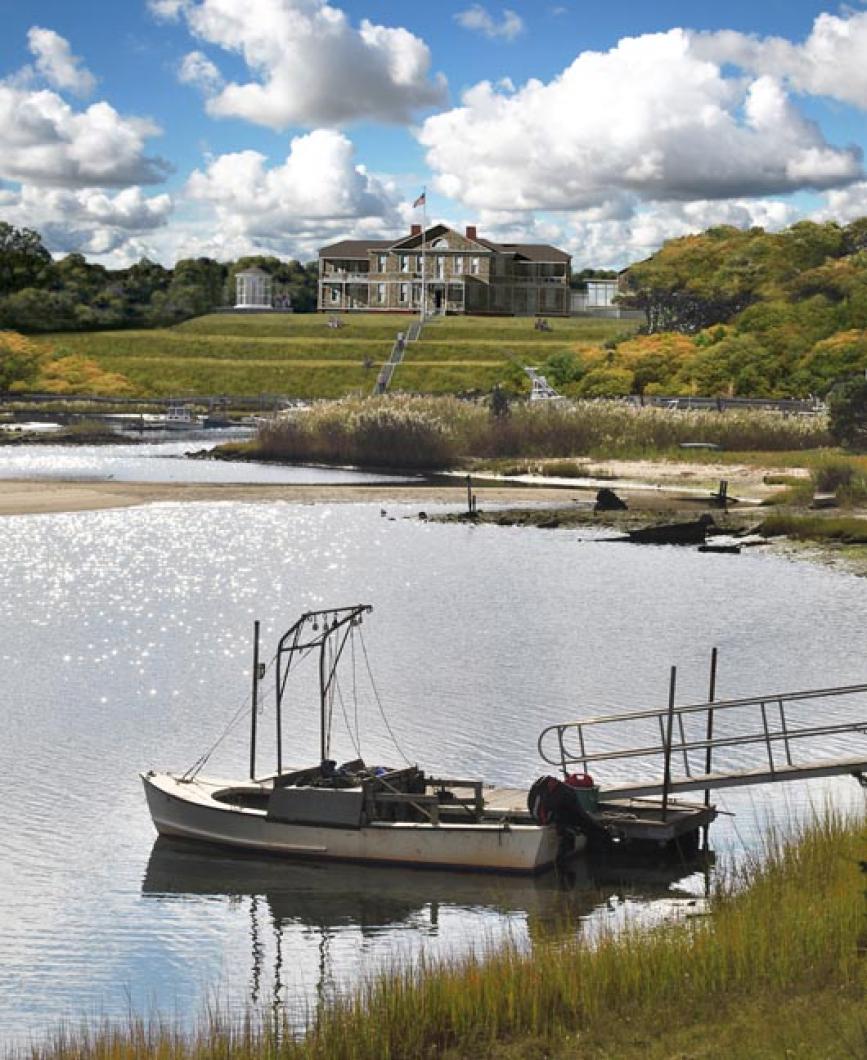The Martha’s Vineyard Museum would restore the former Marine Hospital’s view to Vineyard Haven harbor in its ambitious plan to relocate there, renovating the hospital building to house museum staff and collections, razing a 1938 brick addition, building a new barn-like structure running for exhibition and storage space, paving a 50-car parking lot and clear-cutting the property’s front lawns overlooking the Lagoon Pond, which have become overgrown in recent decades.
Speaking before the Martha’s Vineyard Commission last Thursday in what was dubbed an informal public service review, museum director David Nathans, along with South Mountain Company president John Abrams and Boston architects Conrad Ello and Matt Oudens, presented preliminary designs to convert the decrepit marine hospital building in Vineyard Haven to a state-of-the-art collection and exhibition space.
Throughout the first half of the 20th century the marine hospital treated soldiers and sailors returning from two world wars, but in recent years the sick patient has been the hospital itself as it has fallen into disuse and disrepair.
Mr. Abrams and his team from South Mountain Company along with Mr. Ello and Mr. Oudens — familiar to some Islanders as the architects of the proposed West Tisbury library expansion — were enlisted by the museum in November and funded by an anonymous patron to carry out a feasibility study on the new location.
“I’ve had a 10-year love affair with the property,” said Mr. Abrams. “I have considered many uses with current owner Barbara St. Pierre over that time and this is really the most exciting one so far.”
The hospital sits on four and a half acres less than a half-mile from downtown Vineyard Haven. The new plan calls for dismantling the 1938 brick addition on the southern façade of the building, which Mr. Abrams characterized as “incongruous” and difficult to renovate, and adding exhibition space in a long 7,500-square-foot western wing, set perpendicular to the hospital, that would be tucked into the property’s trees and also serve as a noise buffer for abutters.
The addition also would contain a function and lecture hall that Mr. Abrams said would be able to hold 60 to 80 people. The basement of the new building would be used for badly-needed climate-controlled storage space, while an additional storage shed to house the museum’s large objects would also be built behind the new wing.
The marine hospital itself would house staff offices and a research library on its second floor, while the first floor would contain a classroom, the museum store, the museum entrance and lobby as well as a seating area. The iconic Fresnel Lens familiar to visitors of the current museum in Edgartown would earn a prominent spot on the museum’s pond-view lawn.
If the plan is successful the most marked change may be to vistas from across the Lagoon. For much of its life the hospital enjoyed an unimpeded view of Beach Road and downtown Vineyard Haven and was a commanding presence on the coastal pond, but years of growth have all but severed it from the waterfront. To restore the stately terraced lawns of the property, the museum would have to clear-cut dozens of trees, a method rarely applauded by Island conservation groups.
“We talked to Jane Varkonda, the conservation commission agent in Tisbury, and said, ‘How do you think the [conservation commission] would react to clearing that hillside?’ and she said they would love it,” Mr. Abrams reported.
To combat nitrogen loading in the lagoon, Mr. Abrams said the museum would employ a composting waste disposal system. The museum would also aim for a state of the art, energy-efficient design.
“I think it’s great,” said commission member Holly Stephenson, who suggested the museum also install a kayak launch on its waterfront, an idea Mr. Abrams applauded.
“You did exactly with your plan what I was hoping you would do which is open the view up to the harbor, because right now the building is pretty well hidden and a lot of people have no idea that it’s even there,” said commission member Fred Hancock.
The former hospital is located in a residential neighborhood; museum staff met with abutters last week in a joint meeting with the town planning board to gauge community support.
“It was an unusual meeting,” said Mr. Abrams. “They were wildly supportive and I don’t think there was a negative voice in that room, was there?”
“No, and we asked for it,” responded Mr. Nathans.
Not everyone at Thursday’s meeting was supportive of the plan.
“There’s certainly talk going around about people not liking these McMansions on the Island. Well there’s one right there,” said Edgartown commission member James Joyce, pointing to a simulation of the new museum.
“It’s a look that’s appropriate for a municipal institution and not to a private home,” shot back Mr. Hancock.
The project now enters a critical phase. Mr. Nathans said the museum is trying to get an extension on an option on the property that expires on Jan. 31. If the option is extended, the museum board must soon decide whether to buy the property, a decision that would be based largely on whether board members believe the museum can raise the money for the project.
A $35 million fundraising effort to relocate the museum to a 10-acre plot in West Tisbury foundered two years ago and was scrapped.
Mr. Abrams said he sees limitless potential in the new property. “The place is run down, it’s dilapidated but it’s still incredibly beautiful,” he said.







Comments
Comment policy »